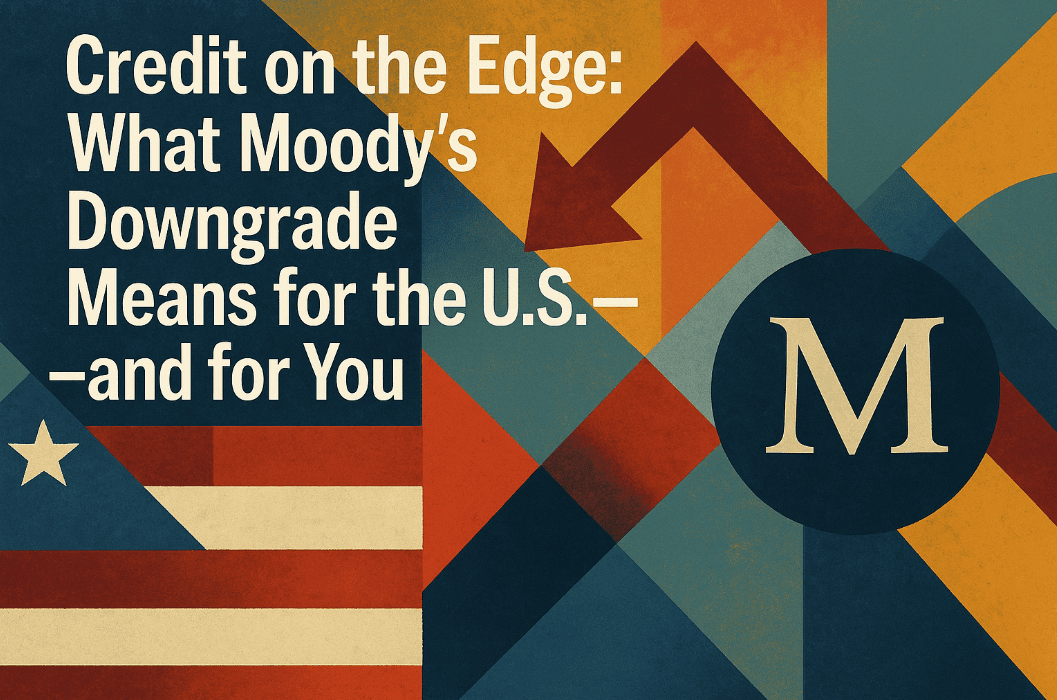Credit on the Edge: What Moody’s Downgrade Means for the U.S.—and for You

Introduction
In May 2025, Moody’s downgraded the U.S. long-term credit rating from Aaa to Aa1, the first time in over a century the country lacks a top-tier rating from all three major agencies. The downgrade cites soaring federal debt exceeding $36 trillion, over $1 trillion in annual interest payments, and persistent fiscal deficits. Although Moody’s changed its outlook from negative to stable, it warned of troubling long-term fiscal trends. Markets reacted with higher Treasury yields, a weaker dollar, and falling stock futures. Treasury Secretary Scott Bessent criticized the move amid tax-cut debates. This downgrade aligns Moody’s with earlier cuts by Fitch (2023) and S&P (2011). The Calisade Digest explores the implications, examining sovereign credit mechanics, fiscal policy challenges, and how bond markets reflect investor sentiment. Despite the U.S. dollar’s reserve status, the downgrade signals that unchecked debt and political gridlock are increasingly risky.
Credit Ratings Refresher
Sovereign credit ratings are assessments of a country’s ability and willingness to repay its debt, issued by the major credit rating agencies—Moody’s, S&P, and Fitch. These ratings serve as a key indicator for investors, institutions, and policymakers worldwide. They evaluate the risk of default based on factors such as debt-to-GDP ratios, tax revenue strength, political stability, economic prospects, market access, and repayment history. Ratings range from AAA (highest quality) to below BBB- (speculative or “junk”).
However, sovereign ratings have limits. They don’t directly measure currency or inflation risk. For example, countries like the U.S., which borrow in their own currency, are theoretically always able to repay debt by printing money—though this can lead to inflation or currency devaluation. Ratings also don’t reflect political ideology, but persistent dysfunction (e.g., repeated debt ceiling standoffs) can impact ratings.
There’s an important difference between a downgrade—a concrete lowering of the rating—and an outlook revision, which signals potential future changes. Outlook changes influence market sentiment and borrowing costs even without a formal downgrade. In 2024, Moody’s retained the U.S. AAA rating but expressed concern over rising debt and governance issues—highlighting how ratings also serve as warnings to governments and investors.
The Downgrade Timeline
Over the past decade, the U.S. has experienced a gradual decline in its sovereign credit standing, driven not by its capacity to repay debt, but by concerns over how that debt is managed amid worsening political dysfunction and rising fiscal pressures. This erosion began in 2011 when S&P downgraded the U.S. to AA+ following a contentious debt ceiling standoff and doubts about long-term deficit reduction. Despite the downgrade, Treasuries rallied as investors still viewed U.S. debt as a safe haven.
In 2023, Fitch followed suit, citing governance deterioration, growing deficits, and weakening institutional credibility. By then, debt and interest costs had surged, amplifying fiscal concerns. In 2024, Moody’s maintained its Aaa rating but revised its outlook to negative, warning of unsustainable deficits and over $1 trillion in annual interest payments.
In May 2025, Moody’s downgraded the U.S. to Aa1, marking the first time all three major agencies had removed the top-tier rating. The downgrade cited a $36 trillion debt load, persistent 7%+ fiscal deficits, and political gridlock. Market reactions were modest, as Treasuries remain globally trusted. Across all three episodes, common themes emerged: political polarization, rising debt-to-GDP ratios, and the growing cost of debt in a high-interest-rate environment—forming a compounding feedback loop of fiscal risk.
Moody’s Downgrade of U.S. Sovereign Debt (May 2025): Economic Implications and Market Reactions
In May 2025, Moody’s downgraded U.S. sovereign debt from Aaa to Aa1, citing rising deficits and long-term fiscal risks. This marked the third and final major credit agency to lower the U.S. rating, sparking immediate market volatility. Bond yields surged, especially for longer-dated Treasuries, as investors demanded higher risk premiums. Equities declined, led by rate-sensitive sectors like tech, and the dollar weakened, while gold and the yen saw safe-haven inflows. Credit markets showed resilience, with only modest spread widening.
The downgrade triggered broader reallocation rather than panic. Global equities dipped, while yields on U.K. and other sovereign bonds rose. Analysts noted the downgrade underscored deeper concerns over U.S. fiscal management, with the Fed likely to adopt a more cautious policy stance amid rising yields. Though inflation expectations were largely unchanged, higher borrowing costs may strain government finances, increasing annual interest expenses.
Internationally, the move dented the U.S.'s "risk-free" perception, prompting modest shifts toward AAA-rated alternatives. Despite official pushback from the White House and Treasury, markets took the downgrade as a warning—not a crisis. While large-cap U.S. firms remain relatively insulated, smaller businesses could face headwinds. Overall, the downgrade adds pressure on policymakers without triggering systemic disruption.
The Debt Spiral
In 2024, U.S. annual interest payments on its federal debt exceeded $1 trillion—surpassing spending on defense and Medicare. Dubbed “The Big Beautiful Bill,” this milestone highlights a structural shift in the U.S. fiscal landscape. Years of rising debt, once cushioned by ultra-low interest rates, now carry a much heavier cost as rates have climbed due to persistent inflation and tighter Federal Reserve policy.
The average interest rate on federal debt has risen from around 1.5% in the 2010s to over 3.2%, with newly issued debt costing even more. With total federal debt over $34 trillion and nearly half maturing within three years, refinancing this debt at higher rates accelerates the cost spiral. This “maturity wall” means old, cheap debt is being replaced by expensive new debt, compounding fiscal strain.
The consequences are significant. Interest is crowding out discretionary spending on infrastructure, education, and defense. Investor confidence may falter if fiscal credibility is questioned, leading to higher yields and worsening the spiral. With no low-rate buffer remaining, the U.S. faces a new era of financial constraint. Rising interest costs are forcing markets, rating agencies, and policymakers to confront the long-term risks of unchecked borrowing.
Conclusion
Moody’s downgrade of U.S. sovereign debt from AAA to AA highlights rising fiscal concerns and political instability, raising questions about borrowing costs and investor confidence. However, the impact on equities may be more favorable. Historically, stocks have shown resilience post-downgrade, often benefiting from a weaker dollar and resulting inflation. Equities, as real assets, can act as hedges against inflation, especially for firms with pricing power and global exposure. Larger companies that can self-finance may also gain advantage as credit tightens. For investors, the downgrade emphasizes positioning portfolios toward resilient, inflation-sensitive, and globally diversified firms to navigate the evolving economic landscape.

